Posted on: March 21, 2022, 06:54h.
Last updated on: March 21, 2022, 12:27h.
Wakayama’s optimism in its ability to secure one of the first three integrated resort licenses in Japan is on the rise. The prefecture is now ready to advance its plans after receiving confirmation of investments.

Last month, there was some doubt over Wakayama’s ability to qualify as a host for a Japanese integrated resort (IR). The country expects candidates to show financial viability when they present their projects, and Wakayama wasn’t there yet.
With the April 28 deadline quickly approaching, the prefecture has made progress. It still needs the local government to give its approval. But the proof of financing is going a long way to giving local leaders hope.
Wakayama Financing in Place
Wakayama’s casino partner is a consortium of companies that make up the Clairvest Neem Ventures KK (CNV) company. Among these are Canada-based private equity firm Clairvest Group, and several executives with ties to Las Vegas Sands. Caesars Entertainment joined the group after its creation and will only play a small role.
Notably, another partner is Mario Ho Yau Kwan. He is the director of CNV, as well as chairman and CEO of eSports organization NIP Group. He is also a son of Stanley Ho, the casino tycoon who previously ruled Macau and who passed away in 2019. Mario Ho is the third child Stanley Ho had with Angela Leong, his fourth wife.
The Ho family name is synonymous with casinos. In discussing Wakayama’s IR project with a prefectural committee last week, Ho confirmed that there were nine equity investors and four financial service providers on board through letters of intent. Among these are Credit Suisse Group, Cantor Fitzgerald, and Hanwha Investment & Securities Co Ltd.
With that confirmation in hand, the prefectural committee felt confident enough in the project to give its approval. Wakayama’s leaders will now vote on the project as the final step before sending it to Japan’s national IR team. There is no established date for the vote to take place.
Closing the Gaps
Although Ho has reassured the committee members that financing is coming, there are still a few unresolved questions the prefecture has to answer. Around 70% of the project’s initial costs will come through loans, while the remainder of the funds will arrive through investments.
Per Japan’s requirements for IR presentations, candidates have to show full capacity to cover the costs. Wakayama is tentatively working on a plan that needs around $3.94 billion. If it cannot show the national government the breakdown of who is supplying what percentage, the project may not get off the ground.
CNV is only responsible for 55% of the initial cost, with Caesars taking on 5% ownership. That leaves another 45% that needs covering. One company, Nishimatsu Construction Co, is part of that latter group. But it is the only company Wakayama has highlighted so far, and its stake is unknown.
April 28 is the deadline for IR candidates to submit their projects to Japan’s national IR team. With a vote still pending by Wakayama’s government and several unknowns still in place, time is quickly running out.
There’s no doubt that Wakayama will beat the deadline – it has been in favor of hosting an IR for years. However, Japan can issue up to three IR licenses initially. This means, if it chooses, it can issue less. If Wakayama can’t confirm its plans appropriately, that selection process will be a little easier.
